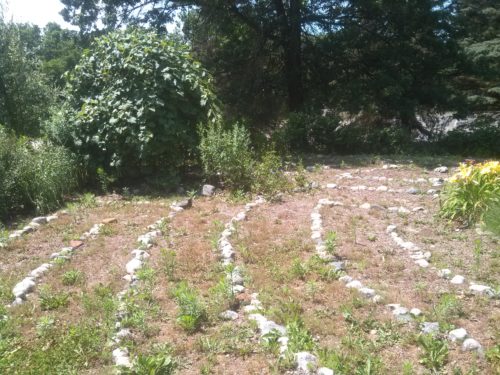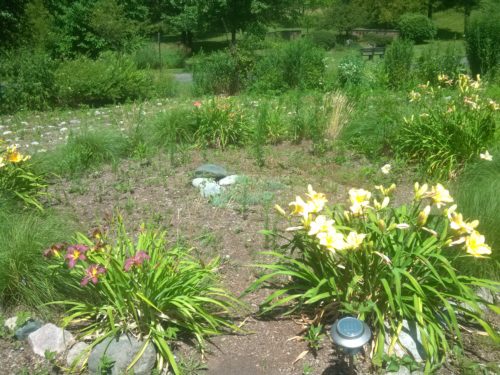[Eric O. Scott is one of our talented monthly columnists. Each month he brings you insight and analysis about issues coming from within or affecting our collective communities. If you enjoy his work, consider donating to our fall fund drive today. You make it possible for The Wild Hunt to continue featuring great writers, unique voices, and news reports every day. Every dollar counts. Please donate today and share the campaign. Thank you.]

To get to the labyrinth, first I have to get through the maze.
The directions seem straightforward: take one main artery to another, cross a bridge over the highway, turn right, and drive. Kalamazoo’s Unitarian Universalist church is supposedly half a mile down the road, easy to find. But big orange signs warn that the way is blocked -– road closed, no thru traffic –– and indeed, not long after turning onto 10th Street, where the People’s Church is located, the road disintegrates from asphalt into huge mounds of dirt and gravel, the natural habitat of Caterpillars and other forms of industrial machinery, rather than my trusty Chevy Cobalt.

Stones outline the path of the People’s Church labyrinth in Kalamazoo, MI. (Photo by Eric Scott.)
Having no choice, I turn left, hoping that with a few right turns I can find a place to cross over into the church’s parking lot. Instead, I find myself lost in a web of wide suburban curves, subdivision streets with no guideposts or markers, roads that wind and twist in ways that defy my city-boy instincts. (While I can’t claim the streets of St. Louis are perfectly logical, most of the time they at least proceed in straight lines, and the avenues go one direction and the streets go another; I have never really learned how to cope with subdivisions, the layouts of which seem practically non-Euclidean.) I find three different opportunities to exit back onto 10th Street, but each time I find the road still obliterated. Eventually I give up and turn back towards the main roads, heading back to my dorm room at Western Michigan University, where I am staying for the summer.
This is the difference between a maze and a labyrinth: though the path of the labyrinth winds and weaves, there is only one route, and with enough steps, one comes to the center and then the exit. There’s no guarantee of escaping a maze.

The center of the labyrinth. (Photo by Eric Scott.)
I have never been so good at meditation – not the seated, peaceful kind, anyway. I never developed the posture for it, much less the discipline to clear my mind of all its worries and distractions at will. But walking meditation does the trick well enough. When I still lived in St. Louis, I liked to stop by the botanical gardens and walk the perimeter, chanting the elements -– air I am, fire I am -– under my breath. With my mind taken up by the rhythm of the chant, and my body engaged in the walk, and my senses suffused with the trees and flowers, I could find my way to peace. I needed to be so embodied to become bodiless.
And that was why I sought the labyrinth: in its journey to a center, the labyrinth serves as a pilgrimage in miniature. Though its footprint is only a few meters in diameter, the path of a labyrinth is an order of magnitude longer. As we follow its contours, its sharp angles and snake-backs, we see landmarks again and again, but changed again and again by the new vantage. And when we come to the center, we can stop, survey the space around us again, and realize that the destination is only halfway through the journey. Much of my interest in the subject comes from my friend Travis Scholl, a Lutheran preacher and a fantastic writer, who has written a book on his experiences with labyrinths; I was thinking of him when I started looking for one in Kalamazoo.
After my other attempts at finding a labyrinth went bust (I’m looking for the labyrinth, I told the clerk outside a Catholic retirement community; The what? he replied; I later found the spot on the map bulldozed and waterlogged), I came back to 10th Street. It was still ripped apart, and I had no business driving on it, but I cut across a flat part of the construction into the church parking lot. The place was completely empty, unusual for a weekday afternoon. It doesn’t look like many people from the congregation manage to get out to the church thanks to the construction, nor even the staff; from what I can tell of the maps, there’s no other way into the parking lot except from 10th Street, so even the groundskeepers are shut out.
As a consequence, the labyrinth itself is overgrown, weeds poking up through the dirt. So many vines cover a trellis at the edge of the circle that at first I can’t tell that it is the entrance. Not wanting to damage anything, I press gently against the green leaves and tendrils and push them aside, stooping down low to pass into the circle of stones.
It has been a tumultuous year, for me and for the world, and though it’s a hot summer day as I’m walking this path, my mind is already turning toward the autumn, toward the winter. The things that are on my mind aren’t so different from what’s on everybody’s mind, I think: I’m worried about politics and justice, about my family and my job, about my coven and my future. And often it’s good to worry: sometimes it’s paralyzing, but it’s often the impetus for action.
Still, you can’t worry all the time: sometimes you need a long walk through the pale stones, feeling the wet afternoon heat on your skin, making your way to the center of the labyrinth. There is nothing special about that center point: here there are stones and lovely flowers, but there are stones and lovely flowers all along the path. Reaching the center is not the point, really. It’s the motion, the journey; the stillness in the movement. I can’t find the gods by sitting still. I need to walk.
Donate to the 2016 Fall Fund Drive. Help support independent journalism.
* * *
The views and opinions expressed by our diverse panel of columnists and guest writers represent the many diverging perspectives held within the global Pagan, Heathen and polytheist communities, but do not necessarily reflect the views of The Wild Hunt Inc. or its management.
The Wild Hunt is not responsible for links to external content.
To join a conversation on this post:
Visit our The Wild Hunt subreddit! Point your favorite browser to https://www.reddit.com/r/The_Wild_Hunt_News/, then click “JOIN”. Make sure to click the bell, too, to be notified of new articles posted to our subreddit.
Thank you for this.